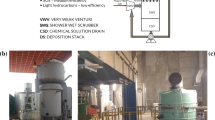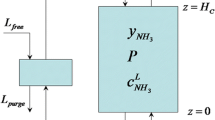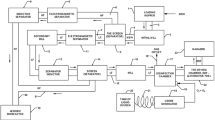Summary
The accumulation capacity for hydrophobic compounds of absorption agents employed in biological waste air purification was substantially affected by the varnish particles contained in the scrubbing liquid. The growth of the mixed population of microorganisms in the scrubbing liquid was not influenced by addition of different absorption agents and solvents with the exception of dibutyl-diglycol. The highest specific degradation efficiency and decrease of stripping was achieved in the presence of phenylmethylsilicone oil.
Similar content being viewed by others
References
Bergmeyer, (1986) in: Methods of Enzymatic Analysis, Vol. II, Verlag Chemie
Ewald M., Hermann K. und Weidmann M. (1987). Vom Wasser, 68, 165 - 175
Feige I., Müller-Hurtig R. and Wagner F. (1989). Dechema Biotechnology Conference Vol. 3. Part B. Frankfurt, 708–711
Feige I., Müller-Hurtig R. and Wagner F. (1991), Bioprocess Engineering (submitted for publication)
Feige I., (1991). Thesis, TU Braunschweig
Schippert E., (1989), Reinhaltung Luft 49, 270
Author information
Authors and Affiliations
Rights and permissions
About this article
Cite this article
Feige, I., Müller-Hurtig, R. & Wagner, F. Use of absorbent materials employed in biological waste air purification. Biotechnol Tech 5, 489–492 (1991). https://doi.org/10.1007/BF00155501
Received:
Issue Date:
DOI: https://doi.org/10.1007/BF00155501




